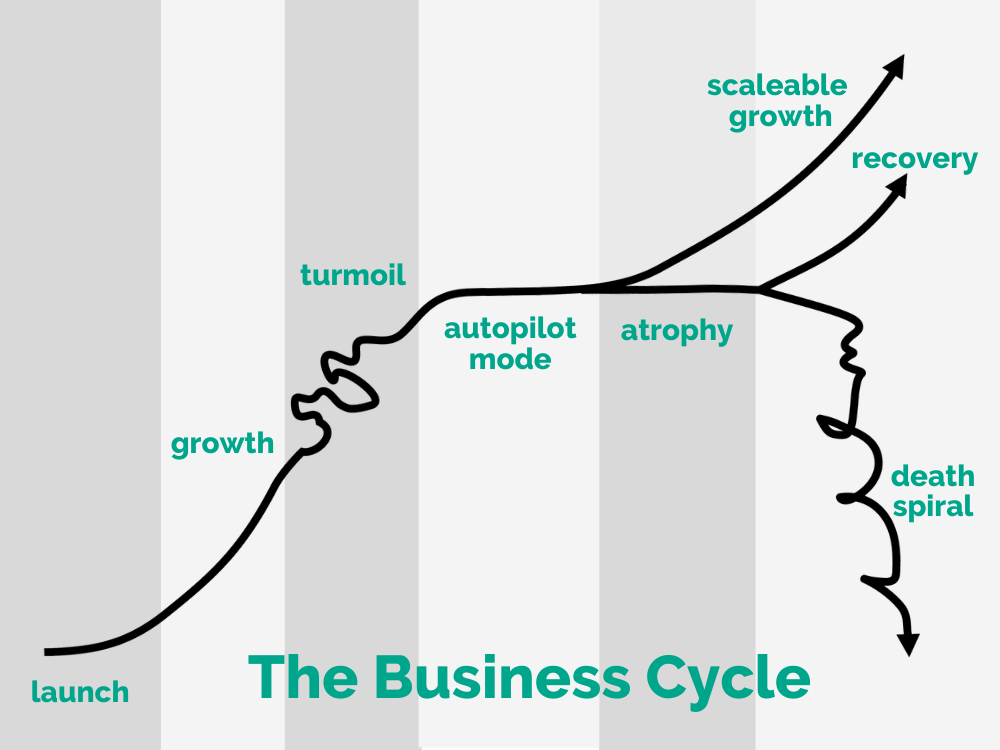
What’s the Difference Between a Formal or Informal Valuation?
May 17, 2021
Fight the Shark: How to Battle Through Business Disruption
June 1, 2021Navigating The Business Cycle

One of my absolute favorite parts of living in beautiful East Tennessee is the fact that we have four seasons. In the winter, it’s cold and we get some snow. The summers are hot, making it ideal for spending days out on the lake. We get extraordinary views of God’s handiwork each fall, as the leaves change colors. And spring? Spring is awful because we get covered in pollen. However, I can’t help but think of the business cycle when thinking of our four distinct seasons. Whether you’re launching your business or guiding it through a recovery phase, understanding each stage of the business cycle can help you avoid disastrous mistakes. So join me as I explore the business cycle in today’s entry.
Follow Along With The Financially Simple Podcast!
TIME INDEX:
- 00:45 – The Business Cycle
- 03:10 – Launching Your Business
- 05:13 – The Growth Phase
- 05:56 – The Washing Machine
- 08:53 – Auto-Pilot
- 11:11 – Atrophy
- 12:34 – Recovery
- 13:55 – Summary

Understanding the Business Cycle
Over the past few months, I’ve been analyzing the clients that my team and I have the honor and privilege to serve. As I’ve gone through this process, I’ve found it quite interesting to see where they find themselves in their businesses when they come to us. The overwhelming trend is that they are in a time of struggle and just need a hand. But what is the business cycle and how do we navigate it? In order to help you to recognize which season or stage of the cycle you’re in, I’m going to explain my business cycle; the business cycle as I see it.
I keep a model of an Apollo series rocket on my shelf—specifically, the Saturn 5. I don’t recall where I got it but the reason I’ve held onto it for so long is that it reminds me of the energy required to launch my businesses. You see, this rocket carried 203 million gallons of kerosene and 318 million gallons of liquid oxygen. The two substances combined to combust and provide enough thrust to lift the rocket from its launching pad. However, of the 521 million gallons of fuel that were stored on the rocket, 80 percent was burned up just to lift the rocket a few feet off of the pad. That’s an enormous amount of energy just to get the mission started!
RELATED READING: Do You Have an Entrepreneurial Personality? Can You Be The Boss?
Perhaps, this reminds you of your early days in business, as it does me. I remember starting off and working so hard, thinking, “Am I ever going to gain any traction?” It can be frustrating to expend so much energy and feel like you’re getting nowhere. But like the Saturn 5 rocket, launching your business requires an enormous expenditure of energy.
The Growth Phase
Once you finally get off the ground, things get a little easier. At this point, you begin making money for the first time. You’re moving and shaking and having a good time. This is what you thought owning a business would be like. Depending on what your business is, this can look a little different but the basics are all the same. Whether you’re like Sarah in Michael E. Gerber’s book, The E-Myth, baking pies or you’re a doctor, a lawyer, or even an auto mechanic, you’ll recognize the signs of the growth phase.
But while you’re enjoying the fun and success of the growth phase, something happens. Things begin to get a little hairy.
The Washing Machine
Not too long ago, I took my family on a white water rafting adventure. Because of all of the mountains in the area, we have plenty of rivers to tube or raft. We chose a rafting guide and set out on a fun family outing. As we made our way downriver, we came to some rapids known as “The Washing Machine.” If you don’t maneuver this stretch just right, it would actually suck the entire raft underwater, leaving us at the mercy of the tumultuous churning waters. Isn’t this just like our businesses?
One moment you’re cruising along having a great time and the next, you’re being tossed about as your raft—or business—goes through turmoil and turbulence. So, what do you do? Well, you might choose to “limit” your growth in an effort to get back to when your business was fun. If you’re a doctor, you might begin limiting which insurances you accept. Maybe, you begin turning down jobs that are below a certain size. Whatever it is, you’re hanging on for dear life and trying to regain control. But the only way you move from growth is to go into atrophy (death) or through turmoil. So, you’ve got to find a way to move through the washing machine.
As I’ve been analyzing our clients, I’ve found that the vast majority are coming to us when they’re in a state of turmoil. They’ve got the battle scars. They have been there and done that. So, what’s next? Well, if you just keep pushing, there’s hope.
Turn On Auto-Pilot
When you’ve finally emerged from the tumultuous terror of turmoil that is the washing machine, you’ll find yourself in a wonderful place. I’m referring to the point when your business is on auto-pilot. This is the point when your business is able to operate without you. I remember being a teenager and taking these offshore fishing trips with my friends. One of my buddies had a boat with an auto-pilot feature.
We would set the course, turn on auto-pilot, and lounge on a bunch of bean bag chairs at the aft section of the boat. Of course, we still left someone to keep watch just to make sure we didn’t hit debris or other boats. But for the most part, we just got to relax while the boat took us to our fishing destination. This is the same idea for your business. Once you’ve passed through the turbulence you move into the auto-pilot phase that affords you a little more freedom from your business. So, how do we move from the turmoil phase of the business cycle to auto-pilot?
During our whitewater rafting trip, our guide told us, if we get thrown from the raft, don’t fight. Just let go. As business owners, we often try to fight the turmoil that’s taking place and it just causes more problems. The best thing to do is just let go, formulate a plan, and get yourself to auto-pilot using the systems and concepts that I’ve been teaching for four years. But here’s where it gets interesting. You’re on auto-pilot and you’re at peace. If you allow yourself to be lulled to sleep, you’ll move into the atrophy phase of the business cycle.
Atrophy & Recovery
One of the dangers of being on auto-pilot is that we begin to rely too heavily on our systems and processes. We can forget that part of being a business owner is taking risks. Without those risks, your business can become atrophied and begin to decline. Ideally, you would use the auto-pilot phase to work on scalable growth so you can avoid falling into the atrophy phase. But, too often, business owners fall into complacency and, eventually, atrophy.
When we find ourselves in a state of atrophy, we have to go through the turbulence once again. That’s part of the recovery phase. Without entering back into that scary and tumultuous washing machine, we enter into the death spiral. I’ve seen companies that were beacons of the community close their doors in a six-month period. That’s just what happens when the business owner becomes complacent when they should be taking calculated, measured risks to move into a season of scalable growth.
Wrapping Up…
Friends, knowing which phase of the business cycle you’re in is invaluable. If you’re in turmoil, keep pushing. You can break through to the auto-pilot phase. Once you’re there, don’t sit on your laurels. Use that opportunity to move into the scalable growth phase. Do whatever needs to be done for you to avoid atrophy or death. If you find yourself in the auto-pilot phase, fantastic! Reach out to me and let me know. I’d love to help you use that time to your advantage.
Life is hard. Life’s frustrating, but it’s so good. The business cycle can be frustrating but it doesn’t have to be. By identifying which stage you’re in and acting accordingly, you can make navigating the business cycle, at least, financially simple.
If you’re struggling through the turmoil or atrophy phases or if you just want to capitalize on the auto-pilot phase, reach out to us. The team at Financially Simple is here to help in whatever way we can!




